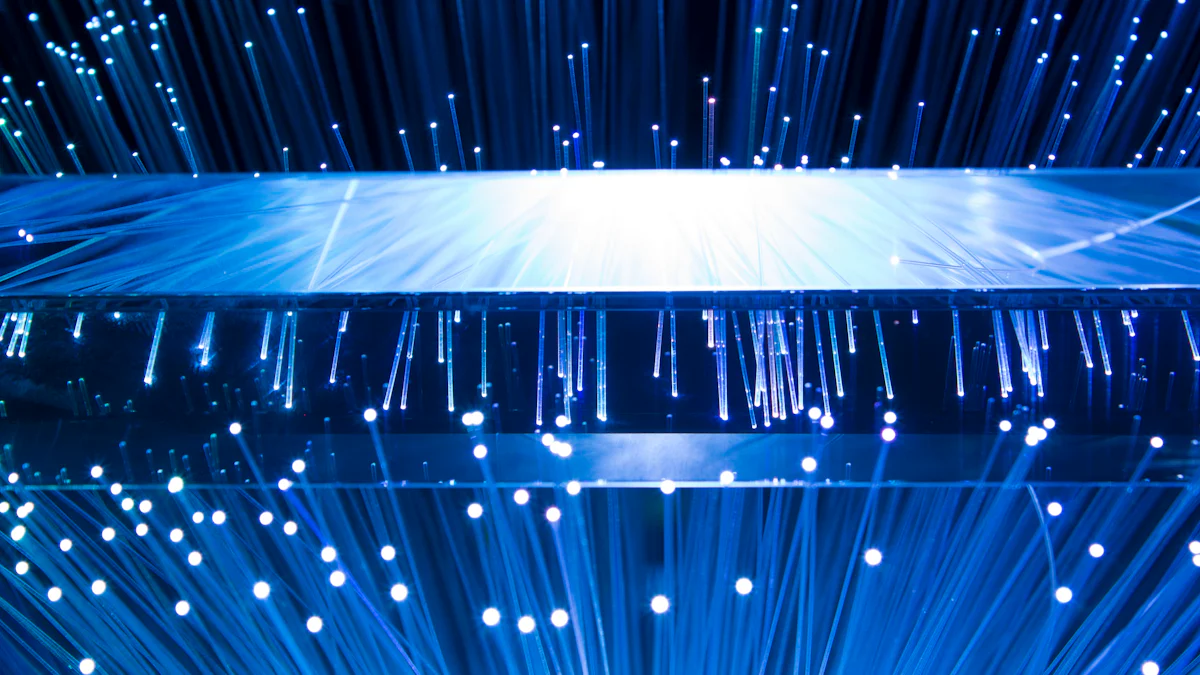Demystifying Multimode Fiber Optics: Cladding Explained

In the realm of multimode fiber optics, understanding the significance of cladding is paramount. Cladding, the outer layer enveloping the core, plays a crucial role in maintaining signal integrity by reflecting light back into the core. This blog aims to demystify the complexities surrounding cladding in multimode fibers, shedding light on its pivotal role in ensuring efficient signal transmission.
What is Multimode Fiber?

When delving into the realm of multimode fiber optics, one encounters a diverse range of options tailored to specific networking needs. Understanding the distinctions between various types of multimode fibers is crucial for optimal performance in data transmission.
Types of Multimode Fiber
OM1
OM1 fiber stands out with its distinctive orange jacket color and utilization of LED light sources. With a core size of 62.5μm and a cladding diameter of 125μm, OM1 cables support 10Gb Ethernet up to 33m, making them suitable for shorter-distance applications.
OM2
In contrast, OM2 fiber also features an orange jacket and LED source, but it boasts a smaller core diameter of 50μm. This design allows OM2 multimode fiber to sustain speeds up to 10 Gbit/s within 82m, primarily used in 1G (1000Mbps) Ethernet setups.
OM3
OM3 fiber, known as Laser-Optimized Multi-Mode Fiber (LOMMF), caters to high-speed demands with its compatibility with 850 nm VCSELs. Supporting bandwidths for 40G and even 100G Ethernet applications up to 100m transmission distance, OM3 finds its niche in short-distance scenarios like within 300m for 10 Gigabit Ethernet.
OM4
For advanced networking requirements, OM4 fiber steps in with its capability to support links up to 125m at speeds of 40 and 100 Gbit/s. Its reduced fiber loss enables the maintenance of signal integrity over longer distances, essential for demanding applications like the deployment of the 100GBASE-SR10 standard.
Core Sizes
Understanding the nuances between core sizes in multimode fibers is vital for optimizing network efficiency and performance:
50μm Fiber
With a focus on precision, 50μm fiber offers a narrower core diameter that enhances signal clarity and reduces dispersion effects. This feature makes it ideal for high-density environments where efficient data transmission is paramount.
62.5μm Fiber
On the other hand, 62.5μm fiber provides a balance between signal strength and ease of connectivity. Its slightly larger core size facilitates easier installation while maintaining adequate signal quality over moderate distances.
Bandwidth Capabilities
The bandwidth capabilities vary across different types of multimode fibers, influencing their suitability for specific networking tasks:
OM1 Bandwidth
While offering reliable performance for basic networking needs, OM1 fibers excel in supporting standard Ethernet speeds efficiently over short distances due to their design optimizations.
OM2 Bandwidth
Similarly, OM2 fibers provide enhanced bandwidth capabilities compared to their predecessors, ensuring seamless data transfer at higher speeds within specified distance limits.
Understanding Cladding

Exploring the intricate world of cladding in multimode fiber optics unveils a realm of paramount importance. The outer layer, known as cladding, envelops the core and serves as a guardian of signal integrity by reflecting light back into the core. This section delves into the multifaceted role of cladding, its dimensions, and material composition to illuminate its significance in ensuring seamless data transmission.
Role of Cladding
Light Reflection
The essence of cladding lies in its ability to facilitate light reflection within the fiber optic structure. By bouncing light signals back into the core, cladding ensures minimal signal loss and maintains the efficiency of data transmission. This mechanism was discovered by Dutch scientist Bram van Heel in 1953, marking a pivotal advancement in optical fiber technology.
Signal Integrity
A critical aspect of cladding is its contribution to preserving signal integrity throughout the transmission process. By confining signals within the core through total internal reflection, cladding prevents signal dispersion and guarantees that data remains securely within its designated pathway. This mechanism safeguards against signal interference and enhances overall network performance.
Cladding Dimensions
50μm Fiber Cladding
In 50μm fiber optics, the cladding boasts a diameter of 125μm, precisely engineered to confine light signals within the core for efficient transmission. This dimension plays a crucial role in maintaining signal clarity and preventing signal leakage, ensuring optimal data delivery across networks.
62.5μm Fiber Cladding
Similarly, 62.5μm fiber optics feature a cladding diameter of 125μm, aligning with the industry standard for guiding light signals effectively within the core. The consistent cladding dimensions across different multimode fibers underscore its universal importance in sustaining signal integrity and network reliability.
Material Composition
Common Materials
The composition of cladding typically involves materials like silica or plastic polymers meticulously selected for their optical properties. These materials are chosen for their ability to enhance light reflection while maintaining structural integrity within the fiber optic cable.
Impact on Performance
The choice of materials for cladding significantly impacts overall performance by influencing factors such as light transmission efficiency and durability. Optimal material selection ensures minimal signal loss and maximum data throughput, underscoring the pivotal role of cladding in shaping network functionality.
Importance of Matching Fiber Types
In the intricate web of multimode fiber optics, the harmony between fiber types emerges as a critical factor influencing network performance. Mismatched fibers can introduce a plethora of challenges, leading to signal loss and performance degradation. Understanding the repercussions of such mismatches is paramount for maintaining optimal data transmission efficiency.
Issues with Mismatched Fiber
Signal Loss
When mismatched fibers are intertwined within a network infrastructure, the repercussions can be profound. The disparity in core sizes and cladding dimensions between different fiber types results in signal loss along the transmission path. This phenomenon hampers data integrity and compromises network reliability, underscoring the detrimental impact of incompatible fiber pairing.
Performance Degradation
The ramifications of mismatched fibers extend beyond mere signal loss, delving into the realm of overall network performance degradation. Incompatible fibers disrupt the seamless flow of data, leading to latency issues, packet loss, and reduced bandwidth utilization. These adverse effects culminate in suboptimal network functionality, hindering operational efficiency and impeding data transfer speeds.
Best Practices
Ensuring Compatibility
To mitigate the risks associated with mismatched fiber types, adhering to best practices becomes imperative. Prioritizing compatibility during network design and implementation is crucial to prevent potential pitfalls stemming from disparate fiber characteristics. By selecting fibers with congruent core sizes and cladding dimensions, organizations can safeguard against signal discrepancies and uphold consistent data transmission quality.
Testing and Verification
A cornerstone of ensuring fiber type compatibility lies in rigorous testing and verification procedures. Conducting comprehensive tests to validate signal continuity, bandwidth efficiency, and overall network performance is essential before deploying multimode fiber networks. Through meticulous verification processes, organizations can preemptively identify any discrepancies arising from mismatched fibers and rectify them proactively to maintain optimal operational standards.
In unraveling the intricacies of multimode fiber optics, one cannot overlook the pivotal role of cladding. Just as a protective shield guards a warrior in battle, cladding shields the core, ensuring signal integrity and efficient data transmission. Understanding cladding is akin to deciphering the hidden language of light within fibers. Delve deeper into this realm to unveil the secrets that propel modern connectivity forward. As Unknown aptly puts it, "Let us begin by understanding what cladding means."
See Also
Contrasts of Single-Mode Fiber Versus Multimode Fiber Optic Cables
Comprehending SC/APC Single-Mode Fiber Optic Connector in FTTH
Single Mode Transmission Provided by Fiber Optic Cables
Duplex Multi-mode Fiber Optical Patch Cable
Insight into 12 Fibers LC/UPC Single-Mode Color-Coded Fiber Pigtail


